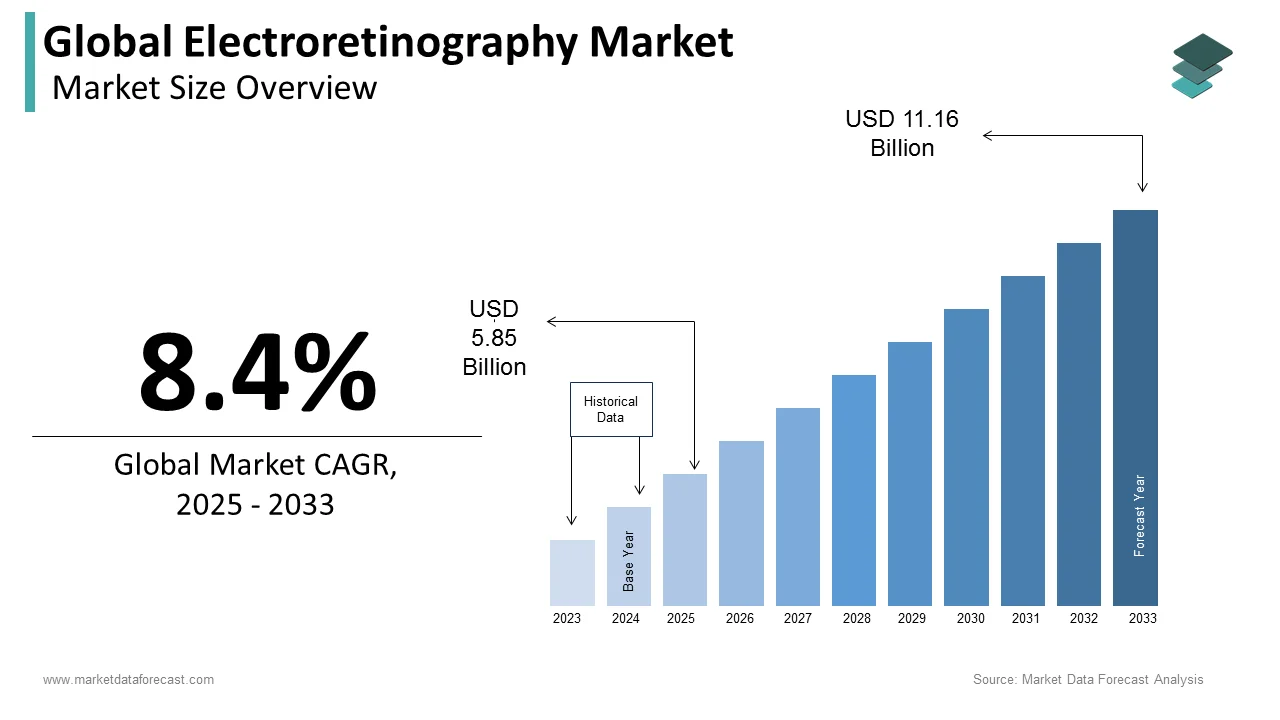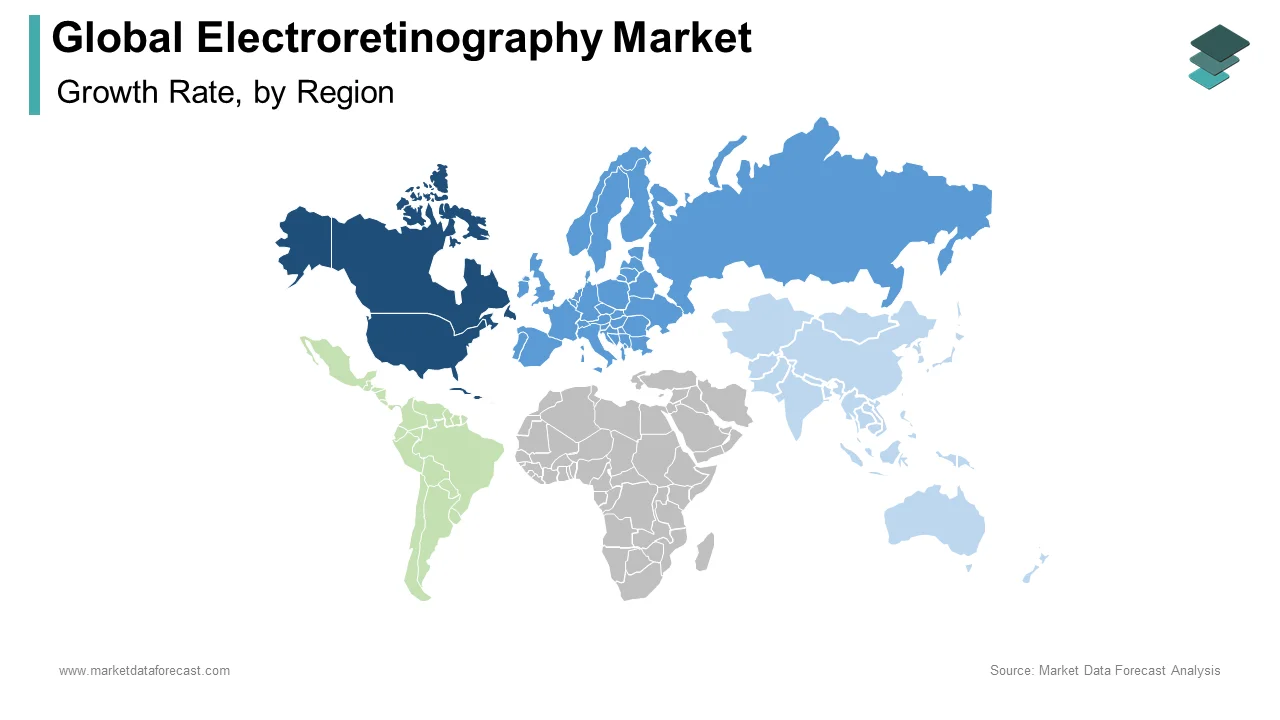Global Electroretinography Market Size, Share, Trends & Growth Forecast Report By Product (Fixed and Portable), Industry (Clinical Use and Research Use), and Region (North America, Europe, Asia-Pacific, Latin America, Middle East and Africa), Industry Analysis From 2025 To 2033.
Global Electroretinography Market Size
The size of the global electroretinography market was worth USD 5.4 billion in 2024. The global market is anticipated to grow at a CAGR of 8.4% from 2025 to 2033 and be worth USD 11.16 billion by 2033 from USD 5.85 billion in 2025.

Electroretinography is the study of electrical impulses sent by the retina in response to light. Electroretinogram is an eye test that tries to detect abnormalities in the functioning of the retina. The retina is the innermost light-sensitive layer of cells that translates images into electrical impulses for the brain to create visual perception. The retina comprises many layers of cells with varied functionalities and purposes that coordinate to make image recognition possible. There are photoreceptor cells (rods and cones) that detect light and transmit signals to intermediary cells (Muller cells and bipolar cells). Finally, the Ganglion cells transmit the impulses that are recorded by the brain as images. In this test, an electrode in the form of a thin wire or a contact lens is placed on the cornea (front part) of the eye after dilating the patient's eyes and anesthetizing him/her. This electrode will register the electrical impulses while the eyes are subjected to various image and light inputs. It will help the physicians calibrate the retinal defect's exact nature and prescribe the appropriate course of action.
MARKET DRIVERS
There is general growth in the medical and healthcare sector due to the increasing levels worldwide. Developed nations like Japan, Germany, Italy, Finland, and other European countries have an increasingly older demographic. Due to this population reason, many of these nations have resorted to importing younger people from less developed nations to balance the lack of taxpayers. This simultaneous rise in population due to immigration and an increase in the elderly population in these nations is expected to drive the healthcare sector and the electroretinography market. With the rapid industrialization and urbanization of many Asian economies, several people have jobs paying much more than they did a few decades ago. This increase in income has contributed to people being able to access better healthcare facilities for themselves and their loved ones. With China's one-child policy, many young Chinese families have four parents and eight grandparents to take care of. With increased health complications due to old age, the Electroretinography market seems very promising in China. Countries like India, Malaysia, Indonesia, Taiwan, and Australia are also anticipated to be key markets for electroretinography due to their burgeoning economies and growing populations.
MARKET RESTRAINTS
However, many people worldwide are still stuck in abject poverty and cannot afford quality healthcare. Prohibitive pricing of diagnostic testing in many countries hurts the market by access to wealthier patients. Lack of awareness among people and the inability to afford treatment are two main factors restraining the growth of the global electroretinography market.
Impact Of COVID-19 on The Global Electroretinography Market
The disease has spread to nearly 100 countries worldwide since the COVID-19 virus outbreak in December 2019, prompting the World Health Organization to declare it a public health emergency. An Electroretinography (ERG) is a system that tests the retina's functional ability to react to light by measuring its functional ability to respond to light. Electroretinograms have become the first line of care for eye disorders and diseases due to the need for rapid diagnosis. The eye is fitted with a sophisticated contact lens that is connected to a monitor. A light is flashed in the eye, and the retina should respond every time the light flashes, resulting in a wave recorded on the screen. Before cataract surgery, an ERG is used to determine if there is a sufficient retinal function to warrant surgery and to diagnose various retinal diseases. Many markets focus on coronavirus-related research and producing related medical equipment; the electroretinography market has had negative growth during this pandemic.
REPORT COVERAGE
|
REPORT METRIC |
DETAILS |
|
Market Size Available |
2024 to 2033 |
|
Base Year |
2024 |
|
Forecast Period |
2025 to 2033 |
|
CAGR |
8.4% |
|
Segments Covered |
By Product Type, End-Use, and Region. |
|
Various Analyses Covered |
Global, Regional, and country-level analysis; Segment-Level Analysis, DROC; PESTLE Analysis; Porter’s Five Forces Analysis, Competitive Landscape; Analyst Overview of Investment Opportunities |
|
Regions Covered |
North America, Europe, APAC, Latin America, Middle East & Africa |
|
Market Leaders Profiled |
Konan Medical, CSO Italia, Diagnosys LLC, LKC Technologies Inc, Electro-Diagnostic Imaging Inc., Roland-consult, Diopsys Inc., Metrovision, and Others. |
SEGMENTAL ANALYSIS
By Product Type Insights

Based on product type, the Fixed ERG machines segment offers a full range of functionality in exchange for ease of movement and portability. These machines are suitable for large multi-specialty and single-specialty hospitals that can attract a large number of patients. Portable EGR machines are easy to carry and can be transported with an ease that is not possible with fixed machines. However, most portable machines are not as good as fixed alternatives and have reduced functionality. These are most suitable for clinics and mobile hospitals that operate in regions that lack permanent infrastructure facilities. Since both machines have different clientele, they have steady markets with healthy growth rates.
By End Use Insights
While machines are mostly used on humans in Clinical medicine, the research sector uses multiple animal species to understand the structure eye and develop new techniques and procedures. The machines used in research, as a result, are also quite different from their clinical brethren. Primates, Rodents, and other small animals are routinely used in laboratories for research purposes.
REGIONAL ANALYSIS

Geographically, the North America and Europe regions are currently the largest markets for electroretinography; with the rising population levels and decreasing unemployment in these regions, the market has a bright future. Among all those regions, the North American market contributes the largest share with a high compound annual growth rate across the globe in the electroretinography market by owning many advantageous factors such as technological advancement. By following the North American region, the European area is recorded as the second-largest revenue growth share region by owning many factors like the development of facilities. As expected during the forecast period, the Asia-Pacific region contributes a high and fast compound annual growth rate due to developing countries such as Japan, China, and India. The Middle East and Africa region are contributing to the smallest revenue growth share.
The region of Asia Pacific is anticipated to grow with the highest CAGR during the upcoming years. It can be attributed to the region’s large population and growing economy.
KEY MARKET PLAYERS
The list of key competitors leading the global electroretinography market profiled in this report is Konan Medical, CSO Italia, Diagnosys LLC, LKC Technologies Inc, Electro-Diagnostic Imaging Inc., Roland-consult, Diopsys Inc., Metrovision, among others.
RECENT MARKET HAPPENINGS
- Scientists from Peking University, Beijing, created a soft Graphene Contact lens Electrode (GRACEs) that addressed patient discomfort due to rigid electrodes, limited types of electroretinograms with a single type of electrode, reduced signal amplitudes and stability, and excessive eye movement. They made sure that the lens did not have any wrinkles by growing it on curved quartz molds.
- Pattern Electroretinography was a handy tool for evaluating patients with early-stage Glaucoma, particularly Glaucoma suspects. According to the latest article published by the authors Porciatti and Ventura in Current Ophthalmology Reports, the Pattern Electroretinography of the patients at risk of progression from suspected to manifest glaucoma reveals alterations in signal even before they start to lose visual field and optic nerve tissue.
- A new technique invented by a team of researchers from the University of Bradford, UK, led by Dr. Declan McKeefry, was able to 'silence' the L- and M-cones and the rods so only the signals from the S-cones are picked up by using stimuli at different wavelengths. This novel method addresses the shortcomings of the usual Electroretinography method that cannot distinguish between the different types of cones. Machines that integrate this facility can break ground into a virgin market.
MARKET SEGMENTATION
The global electroretinography market research report has been segmented based on product type, end use, and region.
By Product Type
- Portable ERG Machines
- Fixed ERG Machines
By End Use
- Clinical Use
- Research Use
By Region
- North America
- Europe
- Asia Pacific
- Latin America
- The Middle East and Africa
Frequently Asked Questions
What factors are driving the growth of the electroretinography market?
The growing prevalence of retinal diseases, the aging population, and the growing demand for non-invasive diagnostic tests majorly drive the growth of the electroretinography market.
Who are the major players in the electroretinography market?
LKC Technologies, Inc., Diopsys, Inc., Roland-Consult, Metrovision, and Heal Force Bio-meditech Holdings Limited are some of the notable companies in the electroretinography market.
What regions are driving the growth of the electroretinography market?
The electroretinography market is growing globally, but some of the regions driving the growth include North America, Europe, Asia Pacific, and Latin America.
What are some of the challenges facing the electroretinography market?
The high cost of devices, the availability of alternative diagnostic tests, and the need for specialized training among healthcare professionals are majorly challenging the growth of the electroretinography market.
Related Reports
Access the study in MULTIPLE FORMATS
Purchase options starting from $ 2500
Didn’t find what you’re looking for?
TALK TO OUR ANALYST TEAM
Need something within your budget?
NO WORRIES! WE GOT YOU COVERED!
Call us on: +1 888 702 9696 (U.S Toll Free)
Write to us: [email protected]
